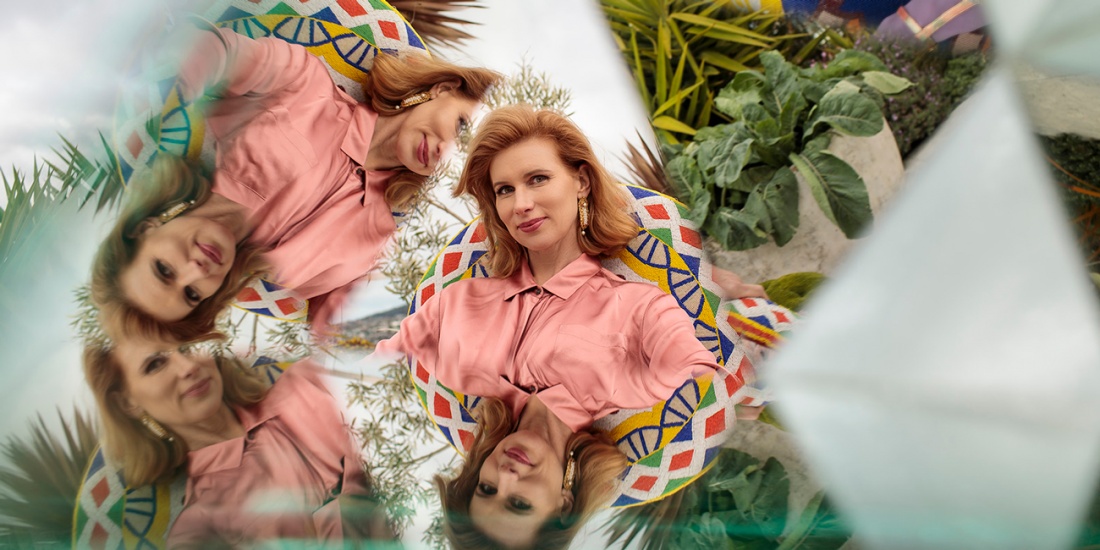Kirsha Kaechele, artist and curator, Eat The Problem
Eat the Problem is a way of thinking and being. It is about not shunning the undesirable, but figuring out how to contextualise it so that it becomes something worth celebrating ...
Our ecosystems are fragile things – a balance of flora and fauna existing in harmony. Introduced species of plants and animals can have severe adverse affects on our wildlife, leading to drastic measures to curb their impact. A new multidisciplinary exhibition at Mona tackles the issue of introduced species in a novel way – re-contextualising the issue and solving by thinking outside the box. Eat The Problem is the name of the performative and surrealist exhibition that looks to turn flaws into features, and invasive species into food and art. Kirsha Kaechele is an artist and curator who conceived the exhibition (and its accompanying 544-page book) as a way to encourage sustainable thinking and how we impact our immediate environment. The exhibition features interactive feasts, infrared heat and cryogenic treatments, and an exploration of cymatics to provoke unique responses in its audience, while the book further educates readers through accumulated contributions from notable chefs, artists, writers and thinkers. To coincide with the book’s release, we spoke with Kirsha Kaechele about the exhibition’s origins and what she hopes it will inspire amongst audiences.
To start, tell me how the idea for Eat the Problem project first originated! What spurred your interest in invasive species and the subsequent idea of interpreting them in an artistic context?
I lived in New Orleans and was fascinated by the invasive nutria problem. Nutria are giant swamp rats—you could call them beavers if you wanted to be kind—but, either way, they are a massive problem because they are literally eating away the landscape. They devour the marsh roots, so the plants die, and the earth just washes away. For this reason, the local sheriff placed a bounty on their tails and local hunters went crazy, there were nutria carcasses floating everywhere. And I just couldn’t understand why we weren’t harvesting their fur, which is very beautiful, or their meat, which is tasty. That inspired me to invite artists to make things from nutria—fashion, food, art—for the 2008 New Orleans biennial. So, those orange-toothed rodents were really the birth of Eat the Problem.
What were some early ideas or concepts you entertained that formed the foundation for the exhibition?
Well, I was very excited by the prospect of a nutria barbecue stand. I was a vegetarian, but I thought: ‘if you eat meat, this is meat that makes sense’. The great New Orleans chefs had tried to popularise nutria in the 1970s, but it didn’t exactly catch on, and I thought it was time for a revival. In retrospect I may have been little too early. I mean, it is a giant rat. But it’s a nice clean one as it’s a herbivore. And now, thanks to a deepened public appreciation of environmental issues and the foodie revolution’s emphasis on terroir, the culinary scene is poised to take animals like nutria on.
The completed exhibition sounds like an incredibly multi-faceted experience, one that aims to provoke an unpredictable sensory response. Can you give us some insight into how this effect has been realised across its various elements?
Yes. Well, the exhibition is multidisciplinary, so it is really more an embodying of the philosophy of Eat the Problem, which at its core is about transforming a flaw into a feature, than it is a literal interpretation. With that philosophical freedom, the exhibition re-contextualises every problem, including the darkness in our own selves, and transforms that into beauty. So, there are musicians and healers who transform the darkness in you into joy and light. Then, you can also literally eat the problem at the feasts.
The Eat the Problem book is filled with contributions from numerous high-profile chefs, artists, writers and philosophers. How do the book and the exhibition intersect, and what does each half add to the discussion surrounding invasive species, ethical environmentalism and creative problem solving?
There is a series of feasts, prepared by Mona chef Vince Trim, that take place inside the exhibition — ephemeral, choreographed installations. And, through the act of dining, the guests become part of the art. Some of the recipes in the book feature in these feasts. And like in the book, each dish is monochrome, so the guests move through the spectrum, tasting every colour (they must come dressed in their starting colour). Also like the book, the table is a rainbow and is musical (QR codes in the book link to sound-art contributions). The table is actually the world’s largest glockenspiel, and this magical instrument is played by in a series of performances curated by Brian Ritchie. Then, there is the element of the human: bodies that lie upon the table and receive treatments— reflexology and cranio-sacral therapy. So, the exhibition embodies the spirit of the book, and puts into practice the transformation of flaw into feature.
The exhibition and book also hints towards the idea that humans are themselves and invasive species. What revelations and possibilities about our consumption habits, societal structure and our own bodies do you hope participants take away from the Eat the Problem experience?
I want them to leave the exhibition feeling connected to nature as a larger system. To realise they are nature and feel affirmed in that. And, to consider problems creatively, simultaneously improving unwanted and ‘unrelated’ issues. It is really the joy of systems-based thinking that the exhibition exists to express. So, even though we are the worst of the invaders, and the book does have recipes (good ones!) for preparing us; and even though the book ends with a Hemlock cocktail to do away with us all for good, I don’t want us to hate ourselves but rather to take delight in a creative problem solving approach that accepts our impact and reframes it.
Both halves of the work look to alter mindsets about what is and isn’t palatable – transforming shit to gold, flaw to feature. Do you see this as something that can and should be applied to other areas of living?
Just every aspect of life! Eat the Problem is a way of thinking and being. It is about not shunning the undesirable, but figuring out how to contextualise it so that it becomes something worth celebrating. And it is systems-based thinking. That applies to everything.
Based on your work piecing this exhibition and book together, what do you predict for the future of systems-based sustainable thinking and furthering culinary experimentation on a sensory level?
I think all the great chefs are already thinking about their work in this way, and expressing that with how they source their ingredients. Every foodie is already a locavore. All I’m suggesting is we extend that ethos further and eat what we have in abundance that we may have shunned or overlooked. Eat it, and eat it guiltlessly. You won’t cause ocean collapse when you indulge in sea urchin or lionfish (all of this, like all great art, is site-specific, of course. You have to eat your local problem. Or ship it over on a wind-powered sailboat.) Extending that to a focus on invasive species just makes for more conceptually interesting culinary experiences. Food is art, so it is not just about flavour, it is about concept as well. And chefs need challenging ingredients to keep things interesting. Our hateable pests are often celebrated on the menus of the cultures from which they originate. They are only scary or unappealing to our uninitiated minds. And, that they are is an asset for haute cuisine, because, being art, it is always seeking novel ingredients.
Are there any other problematic aspects of the world that you could envision tackling through art in one form or another?
Every single one. Social injustice/the class barrier to start. Social work and education are far more effective when paired with art. We see this with our 24 Carrot program and free fashion + music school in New Orleans (Material Institute). These projects are attractive to teenagers because they are stylish and subversive and cool. But they also introduce education and beautification and uplift the community as a whole.
You can probably transform any social problem through creativity. In one example I essentially employed the crack addicts, who steal for a living, to solve the gun problem by setting up a cash for guns ‘pawn shop’ of sorts. The promise of cash inspired them to stop stealing tools and start stealing guns. This was all part of an art installation that looked very appealing and cool. It was transforming a flaw into a feature at its most radical. Another example of this: we intend to add a hacking/tech program to our music and fashion school in New Orleans. I asked the young entrepreneurs in the neighbourhood, meaning the boys on the corner selling drugs, what kind of technology they’d be interested in learning about. They said they would like to learn to build and program drones, so they can follow the police. And create an app that shows their location in real time. Well, that’s an innovative approach to education, and perhaps, ironically, one that might actually get those boys off the street and into an advanced learning opportunity. So many social programs are boring and aesthetically devoid. I think it’s a matter of justice to pair them with creativity, radicality and beauty. Otherwise, how will you appeal to those who need it?
Art is fun and transcends class barriers – science does too – and it is a tool for extending mobility to those born into class disadvantage/injustice. And, if you can secure public housing to combat gentrification, well, bring the artists in. There is a reason every neighbourhood that artists move into triples in value overnight. Poor neighbourhoods should be the best neighbourhoods, to counteract a legacy of a lack of opportunity. Am I talking too much?
Then there are trees and gardens. One need only compare the number of trees in a wealthy suburb to a poor one; an aesthetically rich environment really shifts outcomes for a community. These things are connected. So integrating art and green space and great architecture into social projects has a tremendous impact on outcomes and wellbeing.
Eat the Problem ($277.77, Mona Publications) is on sale now. The Eat the Problem exhibition runs at Mona from 13 April until 2 September. Kirsha Kaechele will be speaking about the book at Riverbend Books in Brisbane on Monday March 25. Get your tickets here.
Image: Rémi Chauvin courtesy of Mona: Museum of Old and New Art

